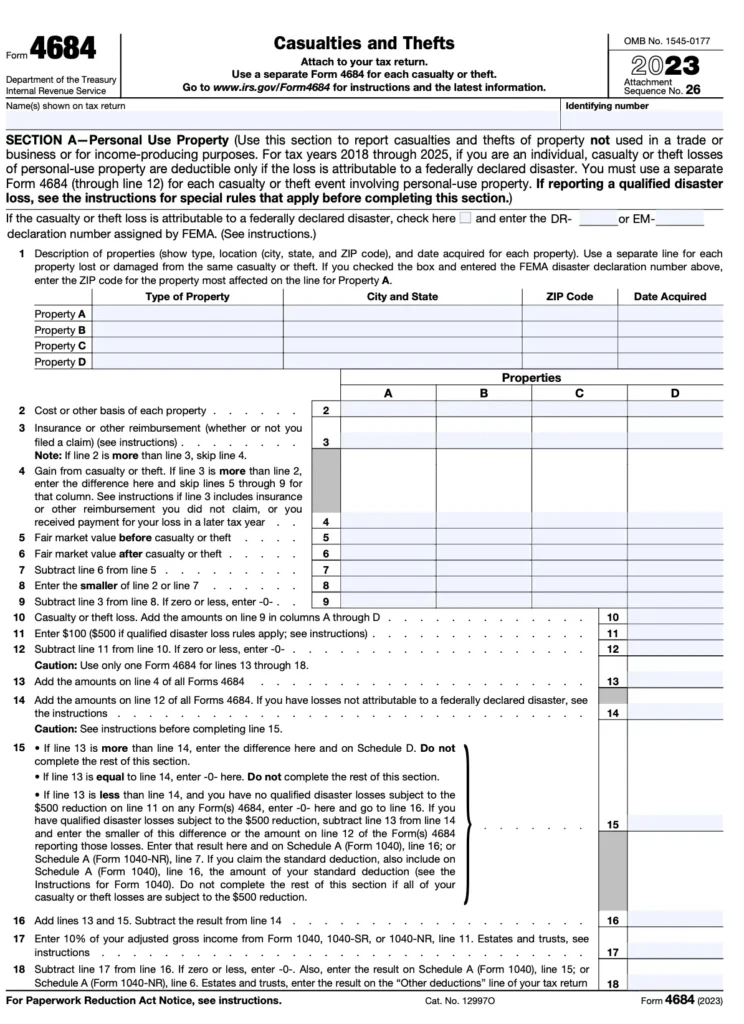Disasters happen. Whether it’s a fire, theft, storm, or vandalism, the IRS allows taxpayers to claim a deduction for certain losses using Form 4684. However, navigating this form requires careful attention to IRS rules, especially when it comes to personal vs. business losses.
In this guide, we’ll walk you through how to file Form 4684, break down each section in simple steps, and help you stay organized with the correct financial statements and documentation. We’ll also highlight some common filing mistakes and offer tips to make your tax filing smoother.
Table of Contents
What Is IRS Form 4684, and When Do You Need It?
Form 4684, officially titled Casualties and Thefts, is used to report losses on property caused by events such as natural disasters, accidents, or theft. These losses can affect:
- Personal property (e.g., your home, vehicle, furniture)
- Business or income-producing property
- Property involved in a federally declared disaster
The IRS allows certain deductions for these types of losses, but only if you meet specific criteria.

Who Must File Form 4684?
You are required to file Form 4684 if:
- You suffered a loss due to a casualty event (like a fire, flood, hurricane, or vandalism)
- You experienced a theft loss (such as a burglary or embezzlement)
- The loss involved either personal-use property or business property.
- You want to claim a deduction on your tax return (Form 1040) or business taxes.
Losses must generally be sudden, unexpected, or unusual.
Essential Documents to Have Ready
Before starting, gather the following:
- Detailed records of the damaged or stolen property
- Insurance reimbursement documents
- Original purchase prices and depreciation data
- Recent financial statements
- Police reports (for thefts)
- FEMA or federal disaster declaration notices (if applicable)
Having these documents handy will make it much easier to follow the instructions on Form 4684 and avoid costly mistakes.

Deadline for Filing Form 4684
Form 4684 should be filed along with your federal income tax return, typically due by April 15 each year (or the extended deadline if you’ve filed for an extension). If you’re amending a previous year’s return due to a loss, you’ll file it with Form 1040-X.
How to Fill Out IRS Form 4684: Section-by-Section
Let’s review how to complete each part of the form. Form 4684 is divided into four distinct sections (Parts A through D), each serving a different purpose.
Step 1: Report Personal-Use Property Losses (Part A)
This section is for casualties and thefts related to personal-use property (e.g., your home, car, or belongings).
You’ll enter the following for each item lost:
- Description of property (Line 1)
- Date acquired and date of loss (Lines 2a & 2b)
- Location of the property (Line 3)
- Nature of the casualty or theft (Line 4)
Then, calculate the amount of loss:
- Fair market value before and after the loss (Lines 5 & 6)
- Cost or adjusted basis (Line 7)
- Insurance or other reimbursements (Line 8)
Line 9 will give you the loss before limits, which is carried over to Schedule A (Itemized Deductions). You’ll subtract $100 per event and then apply the 10% of adjusted gross income (AGI) limit.
Important: Only losses exceeding these thresholds are deductible.
Step 2: Report Business and Income-Producing Property Losses (Part B)
If the property was related to a trade, business, or investment (e.g., rental real estate or equipment), you’ll use Part B.
For each loss:
- Description of the property
- Dates acquired and lost
- Insurance reimbursements
- Fair market value comparisons
- Cost basis and depreciation
Unlike personal-use property, business losses are not subject to the $100 or 10% AGI limits, making them easier to deduct in full.
This part also requires you to provide relevant depreciation calculations and reference entries from your financial statements for accuracy.
Step 3: Total Casualty and Theft Loss Summary (Part C)
Part C summarizes all the losses you reported in Parts A and B.
- Combine all personal losses and business losses.
- Total the insurance reimbursements.
- Subtract those from your calculated losses to find your allowable deduction.
Depending on the nature of the loss, these amounts will flow into your Form 1040, Schedule A, or Schedule C/E.
Step 4: Federal Disaster Loss Election (Part D)
If your loss occurred in a federally declared disaster area, you have the option to:
- Claim the loss in the year the disaster occurred or
- Elect to deduct it from the prior year’s return.
This can help you get a faster tax refund. Just make sure to include proper FEMA declaration numbers and attach any required forms.
Check the box on Line 31 to make this election.
Frequent Filing Errors to Avoid
Even with good intentions, many filers slip up. Watch out for these common mistakes:
- Overstating the value of lost items
- Failing to reduce the loss for insurance payouts
- Forgetting to subtract the $100 and 10% AGI limits
- Not maintaining clear financial statements.
- Missing proper documentation for federal disaster claims
If your case is complex, hiring professional tax services can help ensure everything’s filed correctly.
What Happens After Filing Form 4684?
Once submitted:
- The IRS will process your return with the adjusted loss deduction
- You’ll get a reduced tax bill or a potential refund.
- You may be asked for supporting documents during an audit, especially if claiming a high-value loss.
.
Be sure to retain your receipts, photos, police reports, insurance statements, and all relevant financial records for at least three years.

Conclusion: Let Form 4684 Work in Your Favor
Filing Form 4684 is an essential step in recovering from unexpected losses. When done correctly, it can significantly reduce your tax burden. However, precision is key, especially when calculating losses and applying reimbursement offsets.
Whether you’re reporting a small personal item or significant business damage, accurate Form 4684 instructions and organized financial statements will save you time, stress, and money.










